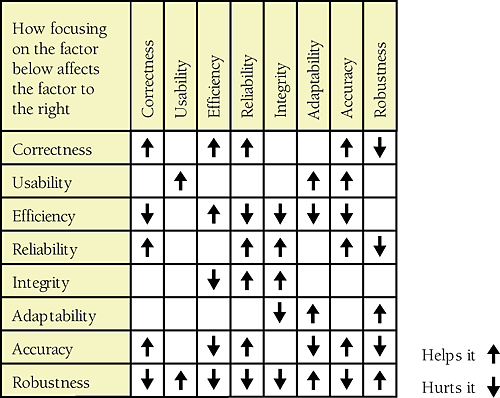20.1. Characteristics of Software Quality
| < Free Open Study > |
| Software has both external and internal quality characteristics. External characteristics are characteristics that a user of the software product is aware of, including the following:
Some of these characteristics overlap, but all have different shades of meaning that are applicable more in some cases, less in others. External characteristics of quality are the only kind of software characteristics that users care about. Users care about whether the software is easy to use, not about whether it's easy for you to modify. They care about whether the software works correctly, not about whether the code is readable or well structured. Programmers care about the internal characteristics of the software as well as the external ones. This book is code-centered, so it focuses on the internal quality characteristics, including
As in the list of external quality characteristics, some of these internal characteristics overlap, but they too each have different shades of meaning that are valuable. The internal aspects of system quality are the main subject of this book and aren't discussed further in this chapter. The difference between internal and external characteristics isn't completely clear-cut because at some level internal characteristics affect external ones. Software that isn't internally understandable or maintainable impairs your ability to correct defects, which in turn affects the external characteristics of correctness and reliability. Software that isn't flexible can't be enhanced in response to user requests, which in turn affects the external characteristic of usability. The point is that some quality characteristics are emphasized to make life easier for the user and some are emphasized to make life easier for the programmer. Try to know which is which and when and how these characteristics interact. The attempt to maximize certain characteristics inevitably conflicts with the attempt to maximize others. Finding an optimal solution from a set of competing objectives is one activity that makes software development a true engineering discipline. Figure 20-1 shows the way in which focusing on some external quality characteristics affects others. The same kinds of relationships can be found among the internal characteristics of software quality. Figure 20-1. Focusing on one external characteristic of software quality can affect other characteristics positively, adversely, or not at all The most interesting aspect of this chart is that focusing on a specific characteristic doesn't always mean a tradeoff with another characteristic. Sometimes one hurts another, sometimes one helps another, and sometimes one neither hurts nor helps another. For example, correctness is the characteristic of functioning exactly to specification. Robustness is the ability to continue functioning even under unanticipated conditions. Focusing on correctness hurts robustness and vice versa. In contrast, focusing on adaptability helps robustness and vice versa. The chart shows only typical relationships among the quality characteristics. On any given project, two characteristics might have a relationship that's different from their typical relationship. It's useful to think about your specific quality goals and whether each pair of goals is mutually beneficial or antagonistic. |
| < Free Open Study > |
EAN: 2147483647
Pages: 334